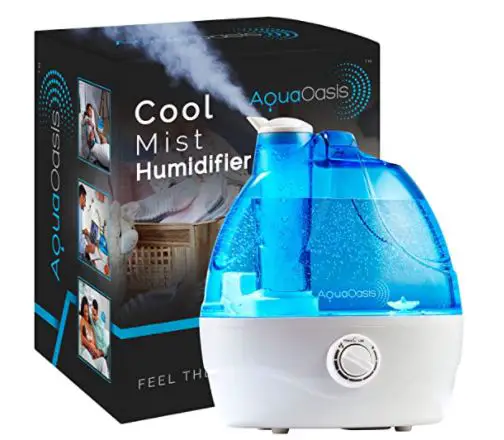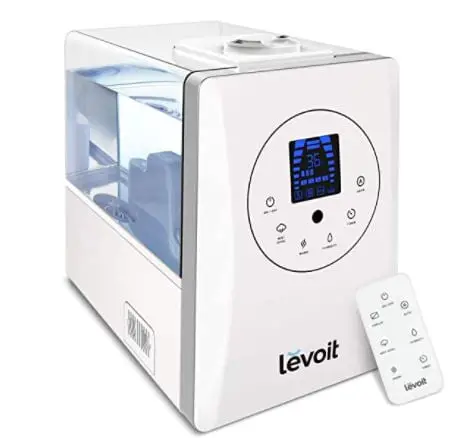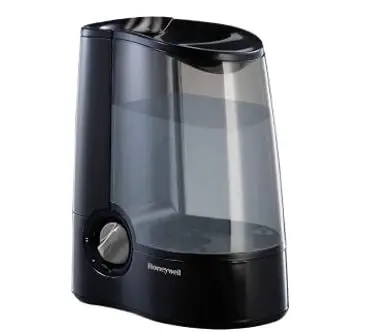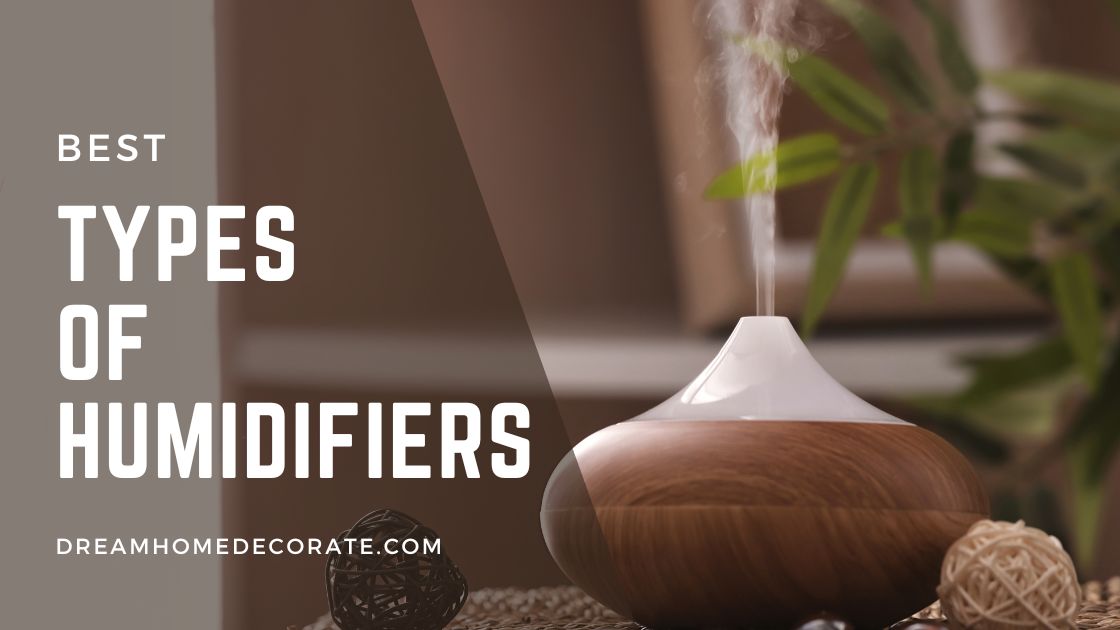There are several types of humidifiers if you want to invest in a humidifier if you’re struggling with seasonal allergies, cold and flu symptoms, or dry skin. Different types of humidifiers can help with these and other ailments. The reason why today, we’ll be telling you all about different types of humidifiers.
Humidifiers add moisture to the air, which is sufficient for healing most ailments. Moisture helps lubricate a dry throat, reduce cough, and break up mucus and respiratory congestion.
With various types of humidifiers out there, it can be challenging to know which one is the best. It depends on your individual preferences, needs, and budget. So we are here to help and point you in the right direction by showing you different types of humidifiers for your consideration.
Types of Humidifiers
Cool Mist Humidifier
The Cool Mist Air Humidifier is a wholesome solution for adults, kids, and babies alike. Please place it in any room around the house and sleep, meditate, read, or relax as comfortably as possible with your family.
Discover a deeper, replenishing sleep experience by improving the air quality at home. Do away with congestion all year long and pass this flu season uninterrupted.
Its whisper-quiet operation lets you study, meditate, read, sleep, care for your baby or do any activity with zero noise distractions.

Features:
- Unnoticeably Quiet
- Auto Shut-Off Function
- Filter-Free Operation
LEVOIT Humidifier Warm and Cool Mist
The humidifier provides both cool mist and warm mist to relieve you from congestion, sinus, dry skin, allergies, bloody noses, cold, flu. It is perfect for all year around use.
The humidifier’s built-in humidity sensor automatically adjusts the mist level to maintain a comfortable humidity level, so you can set it and forget it. If the tank runs out of water, the humidifier will automatically turn off.
Near-silent noise levels and a display-off feature help you sleep through the night while the humidifier works.

Features:
- Warm and Cool Mist
- Auto Mode
- Aromatherapy
Filter Free Warm Moisture Humidifier
Filter Free Warm Mist Humidifier helps to ensure proper humidity levels in your home. Indoor humidity levels between 40-60% can help relieve cough and congestion, keep throat and nasal passages hydrated, and more.
Humidifiers and vaporizers for bedrooms and homes can be helpful during the cold season when it’s difficult to sleep with a cough and congestion.
Filter-free humidifiers don’t require replacement filters. With a 1 gallon tank, you can enjoy a warm mist for up to 24 hours without refilling; It’s ultra-quiet and has an essential oil cup for use with your favorite essential oils.

Features:
- Corded Electric
- Ultra-quiet
- Cough and congestion relief
Common Questions About Types of Humidifiers
What is a humidifier?
Humidifier therapy adds moisture to the air to prevent dryness that can cause irritation in many parts of the body. Humidifiers can be particularly effective for treating dryness of the skin, nose, throat, and lips. They can also ease some of the symptoms caused by the flu or common cold.
What are the common uses of a humidifier?
Humidity acts as a natural moisturizing agent that can relieve dryness. For this reason, humidifiers are often used for relieving:
- Dry skin
- Sinus congestion/headache
- Dry throat
- Nose irritation
- Bloody noses
- Irritated vocal cords
- Dry cough
- Cracked lips
What are the two types of home humidification methods?
Humidifier type most commonly refers to the type of mist the humidifier releases into the air. The two different humidification methods are Warm Mist and Cool Mist, which include Ultrasonic and Evaporative technologies.
- Cool Mist: Typically covers more space and is preferred by parents since there’s not a heating element.
- Warm Mist: Are quieter than cool mist models and leaves your rooms feeling warmer and cozier in the winter.
Cool Mist Humidifier Benefits:
- Because the water is not heated before it is dispersed, these humidifiers typically use less electricity.
- Most parents also opt for cool mist humidifiers to avoid hot water accidents in children’s nurseries, bedrooms, or other common areas where curious fingers may find them.
Warm Mist Humidifier Benefits:
- It is often considered healthier since boiling kills waterborne bacteria and mold, preventing them from entering the air you breathe.
- The absence of an internal fan makes warm mist humidifiers exceptionally quiet to operate.
What are the types of humidifiers?
There are five common types of humidifiers available; cool mist, warm mist, ultrasonic, evaporative, and vaporizers.
Cool Mist Humidifiers
A cool-mist humidifier can add much-needed moisture to the air, soothing your cough and breaking up chest congestion. The best part is, these humidifiers increase the moisture and humidity in a room without raising the temperature.
Warm Mist Humidifiers
Warm mist humidifiers heat the water to create a vapor. The vapor is then cooled before it’s released into the air. The heating process decreases the risk of bacterial contamination and increases purity.
Evaporative Humidifiers
Evaporative humidifiers are similar to cool mist humidifiers because they don’t heat the water to create vapor. Instead, a fan circulates the humidity through a moist wick filter located at the bottom of the device.
This water evaporates into a vapor and is expelled as a spray or mist, creating humidity in the air. This humidifier is ideal for children and pets since it doesn’t generate heat. They’re also safe to place on almost any surface without fear of damaging your furniture.
Vaporizer Humidifiers
These types of humidifiers allow you to choose between a cool or warm mist. Those suffering from cold and flu symptoms can add inhalants to these systems. Even with its multi-use features, vaporizer humidifiers are affordably priced.
Most vaporizers emit visible steam into the air when on the warm setting and a mist when set to cool. Vaporizers are quiet and create minimal dust accumulation.
Ultrasonic Humidifiers
These types of humidifiers use a vibrating metallic diaphragm (usually made of metal or ceramic) to release moisture into the air. The vibrations create water droplets, which are then expelled into the room.
Most ultrasonic humidifiers give you the option of a warm or cold mist. Not only do ultrasonic humidifiers use very little energy to operate, but they’re also reticent.
What kind of humidifier is better?
Both cool and warm mist humidifiers are great options for adding soothing moisture to dry indoor air. Cool mist is a better choice for homes with children and pets, while warm mist models are a little quieter and can help you feel slightly warmer in the winter.
If your allergies are recurrent and you plan to run the humidifier year after year, you may want to invest in a high-quality system.
What are the differences in humidifiers?
Exactly how they do, it is the main difference between the two: One type of cool-mist humidifier uses ultrasonic vibrations to disperse a cool water mist into the air. A steam vaporizer or warm-mist humidifier uses electricity to power a heating element. It boils water and creates steam.
How to clean a humidifier?
- General cleaning includes filling the water tank with a combination of water and white vinegar. Allow this mixture to run in the humidifier for one hour. Rinse out whatever water remains.
- Next, fill it with clean water and run it for another hour before the subsequent use. This guarantees all of the vinegar has evaporated.
- Cool mist and ultrasonic top the list of easy to clean humidifier designs.
Additional Tips Regarding Types of Humidifiers
- For the safety of young children, always use cool mist humidifiers in their rooms or in areas where wandering fingers can find their way to the humidifiers.
- Warm mist humidifiers and steam vaporizers can burn or irritate young children.
- Neglecting regular humidifier maintenance can worsen your symptoms and send unwanted bacteria into the air.
- It’s recommended you clean your humidifier before filling it with more water or every few days, depending on how often you use it.
- How large is the room where the humidifier will be? This will determine the type of humidifier you choose and the size. The larger the room, the bigger the humidifier should be.



